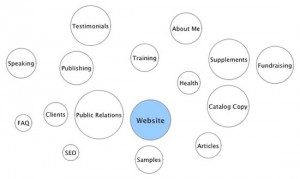Whether you’re just starting out or have a steady stream of clients… there’s no way around it.
But, I understand how easy that project can slip to the back burner.
Heck, I’ve had my website on my to-do list for over a year now.
It’s one of those projects “you’ll get to once <fill in your excuse here>.”
But, how good would it feel to actually check that goal off your yearly to-do list?
Well, today I’m going to show you how to plan your freelance website content… in under an hour.
Now, what we end up with may not be the final plan. But, it will be good enough to get you motivated to finish the job, so you can focus on what you do best — writing.
In fact, if you participate while you read today’s article, you could actually have your website up by the time you ring in the new year.
Ready? Grab a piece of paper and a pencil and let’s get down to business.
First tell me… what do YOU like?
First things first when planning your own freelance website content.
You need some inspiration, as well as a feel for what others are doing.
So before you get started writing, surf the web and find examples of other freelancer websites that you like.
Think of these sample websites as your swipe file.
Once you’ve identified 3-5 websites that you like, write down the types of content you find on each site.
Note their navigation, and any other pages they drive you to from the homepage. Also, keep a record of any color schemes or logos that you like — it will give you a head start when you plan out how your own freelance website will look.
Next, brainstorm your main categories…
There are various ways you can document your ideas in this phase, but I prefer using a mindmap to organize my content.
[Tip: If you’re not familiar with mindmaps, read an article I wrote earlier this year so that you’re on the same page, and then come back.]
Now you can use mindmapping software if you have it, but oftentimes for projects like this I find it just as easy to map out my ideas on a blank piece of paper.
In the middle of the paper, write down the word “website” and draw a big circle around it.
And then around that circle, start jotting down all of the content you could possibly include on your website.
I’m talking about every detail that would make you stand out to a potential client. Experience, strengths, benefits of working with you… anything that sells you.
Don’t worry about editing at this stage, or feeling that something isn’t strong enough. The purpose here is to get it all down on paper without any judgment.
Every time you write down a type of content, draw a circle around it.
So, for example, write down “About Me” and then circle it.
Write “FAQs” and circle it. “Samples,” circle it.
Some other circles you may write down include:
- Articles
- Clients
- Testimonials
- Speaking, training, or anything outside of copywriting
- Various niches
- Specialties
Maybe you’ve just taken AWAI’s Email Copy Made Easy Program.
Or, you’ve specialized in content marketing after taking Brian Clark’s Content Mastery Program.
Write all of that training down, too.
What you’ll end up with is a complete outline of all the categories of content you could potentially include on your website.
Here’s a sample mindmap up to this point:
At this point you’ve actually come pretty far in planning your own freelance website content.
Not that scary, right?
What if you don’t have any samples?
Or, what if you don’t have testimonials… or past clients… or any published articles?
Don’t worry about what you don’t have. Instead, focus on what you DO have.
Potential clients understand when you’re just starting out. And, there are many ways you can still show them that you know what you’re talking about.
For example, you can create writing samples by re-writing a landing page, setting up a mock PPC campaign for a real company, or writing a series of emails up-selling a free subscriber to a product.
Another option is to focus on your experience or background instead.
Let’s say you want to write for the green market. Instead of having a samples page, maybe you’ll have a “Working Green” page. And, on that page you talk all about how your office is totally green — you recycle everything possible, your office runs on wind power, and you’re completely paper-free.
See? Just focus on what you bring to the table.
Now you’re going to break it down…
Once you’ve exhausted all the main categories of content that you could include, I want you to think about each circle as if it’s a page of web copy you’re going to have to write.
So next to each one, write a short list of copy you could include.
For example…
About Me:
- Past work experience
- Hobbies
- Training
Samples:
- Vitamin assignment
- Spec for a supplement company
- Local yoga studio website
- Friend’s SEO project
Now, what you have is a framework of all the content you could potentially have on your website.
Everyone’s mindmap will look different at this point. There is no right or wrong, so don’t worry about comparing or having it evaluated.
Time to organize…
You most likely have a lot of different content on your mindmap. So, your job at this point is to organize it into six or so categories that are the strongest.
Remember, your website tells the client why she should hire you as her web writer. So evaluate each category on whether or not it’s strong enough to get that job done. Don’t worry if you end up missing a type of content “every other web writer has on their website.”
You want content that sells YOU!
So step back and analyze your categories. Which are the strongest? Draw a square around those circles.
Which are the weakest categories at this point in your career? Draw a triangle around those circles.
You may find that two categories seem weak by themselves, but when combined become strong. Or, you may find that two categories — for example, your About Me and FAQ pages — are very similar and should be condensed into one.
Draw a line connecting the two circles, and then draw a square around the pair.
You may also find that some categories may need to become bigger.
Let’s say you wrote down online copywriting as a main category. And you see that you have plenty of content that you could write about, including your experience with PPC, SEO, and email copywriting.
Go ahead and pull those out and write them down as their own main categories. Draw a circle around them and see how they stand up against the other pages with squares around them.
The goal of the mindmap is to identify all of the potential content. And then from there, develop the final pages that do the best job of selling you.
The big moment is here…
You are about to put together your website’s navigation. Can you believe how painless this process truly was?
So, looking at your mindmap, what are going to be the 5-7 BEST possible pages you could put together from this content?
What will make the client say “WOW, I need this web writer working for me!”
Sample navigation:
- About Me
- FAQs
- Articles
- Testimonials
- Health
- Fundraising
- PPC
See? No samples on that website. But you wouldn’t even notice.
OK, pencils down.
You’ve done it. You have planned the navigation and core content of your freelance website, which in turn identifies the pages you need to write.
Final thoughts
Your website is similar to a resume, but it’s much more fun and engaging. You’re not stuck in a template, or limited to one page.
Potential clients will want to see your website. So, make sure it does its job when they do view it.
Remember not to focus on what you don’t have. If you’re new, and you don’t have samples, it’s OK. Focus on your experience, your training, whatever makes you look good.
Plus, once you have samples you’re happy with, testimonials, more training, etc., you can easily add them to your website. That’s the beauty of a website – it can be changed at any time!
So now it’s time to get writing. And, in case you need help with the techie stuff, check out our article on how to make a website for freelance writers.








